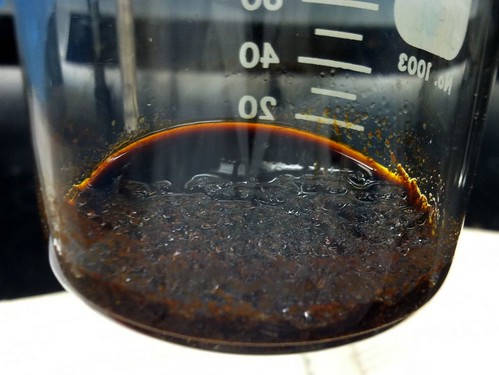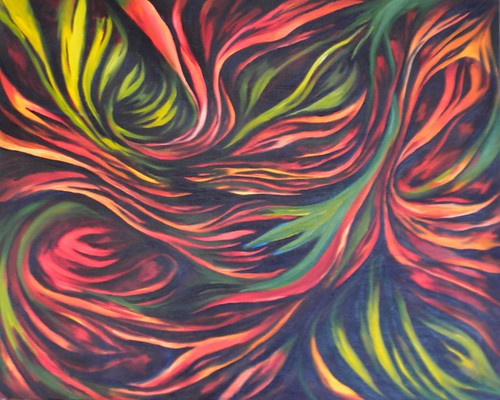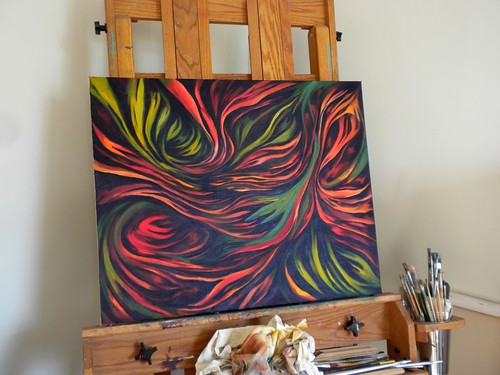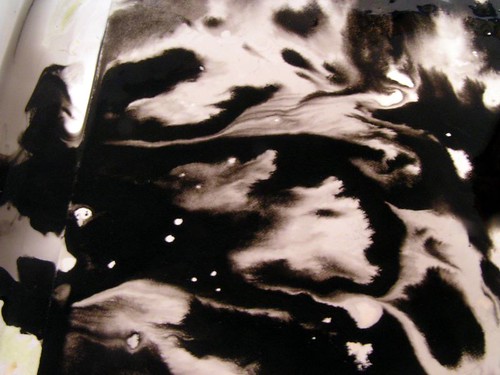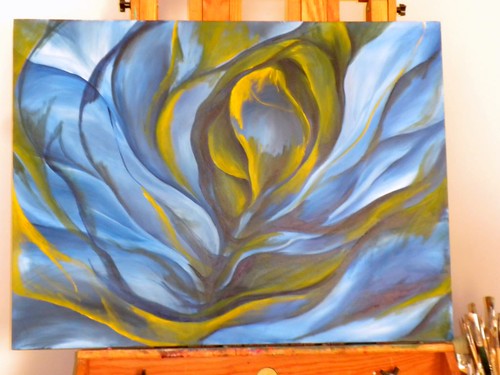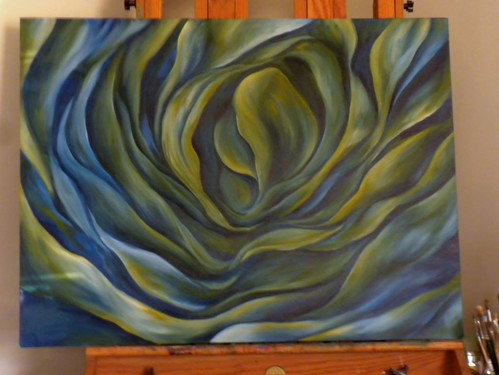One of the biggest downsides of the amount of time I’ve spent in school is that it’s left a paucity of energy and inclination toward painting. I am no longer in school now (it’s complicated) and I am working full time, and it’s wonderful. While I’m still exhausted and have little free time (I’m sure I’ll adjust), I have a much greater motivation toward my studio now that my free time is actually free and not stolen from something else I should be doing.
I’ve had this painting hanging out on my easel for an embarrassingly long time. I started it in a fit of energy back in February 2011, when the release of the new Radiohead album “The King of Limbs” prompted a renewed obsession with all things Radiohead, including “Hail to the Thief.” Increasingly, a lot of my art is a big love affair with music, and I remember distinctly that this painting started when I was obsessing over the song “Where I End and You Begin.”
(Ace video by Juan Pablo Etcheverry – direct link.)
I was going for something complex and writhing, a seething, teeming entanglement of inside and out, other and self becoming one, resonating with those tight drums and extraordinary bass line. Later, I was also thinking about a particularly fascinating reaction in organic chemistry (the nucleophilic aromatic substitution on 2,4-dinitrobromobenzene with hydrazine in ethanol), where the volatility and reactivity of the compounds we used led to uncontrollable side-chain reactions. Our lovely transparent yellow and orange reactants, initially iridescent purple when mixed, became tar-like conglomerates of nitrogen-clumped impurities.
It was such a fitting metaphor for intense interpersonal relationships that become messy and destructive: two entities that are too much alike, too violently reactive, too susceptible to cataclysmic interference from uncontrollable forces; both turn from something pure and inherently open – even luminous – to a singular existence inextricably bonded in toxicity, so dense and dark that no light gets in.
Trying to push toward that exact reaction, I wanted this painting to be highly-contrasting orange and purples. I abandoned it when I over-mixed it all toward a fittingly muddy cadmium red-orange-brown, and its fate was sealed when I noticed the compositional and color similarity to a painting I did years ago.
I’m not done with this idea, though, nor even this painting. The opening lyrics of the Radiohead song speak to the opposite, to not being able to connect and feeling fundamentally separated:
There’s a gap in between,
There’s a gap where we meet,
Where I end and you begin
At first, I interpreted it as dealing with death, literally ending and not being able to connect with someone living. There was more to it, though, an ominous story that hinted at a complicated past and the severing of something that was once intensely linked. The obsessive tone and repetition of the closing lyrics (I will eat you alive / There’ll be no more lies) speak to a level of connectedness that feels essential for survival, a prehistoric, preternatural force evoked from the time when “the dinosaurs roam the earth.” And yeah, love or addiction could certainly feel that way too. I still haven’t sorted what this song is actually about, but I know exactly how it feels, and whatever circumstances or forces brought about the feeling are defined by their relentlessness.
I decided the painting was too blobby and forgiving, that it needed to be darker, with stronger contrast and definition of space. I wanted it to be sharper and better attenuated to the unforgiving severity of being dragged around by one’s heart and need. I took a typical tack, essentially drawing back over the surface in dark blue to redefine the structure of the field.
I am incredibly glad that I’ve started taking photos during the intermediate phases of paintings because I can see that I had what I wanted for a little bit when it was just blue. Then either because I felt too dark (it was a gorgeous sunny day in July, and my heart was full of love and summer) or because I got impatient and wanted to start defining the lights, I went at it with cadmium yellow. When that turned to a bright green, I went with it, thinking, “Sure, why not?”
I think I got blown off course, moving into something more generically “colorful” and balanced, shying away from what I was really thinking about. The green is letting the light in, giving breathing space, relenting. It’s fine, and maybe it could even become pleasant, but that’s not what this painting is about.
This painting’s current state points to all the areas where my studio practice is out of sync. The most obvious problem is that I’m not actually processing emotions, inspirations, and concepts at the time when they’re predominant in my life. Years after the heartbreak, frustration, and existential angst that drove me to begin this painting, it feels artificial to go back and roll around in the past tense now.
The problem that concerns me most, though, is the glaringly obvious disconnect between the ideas and the material / technical addressing of them. For a painting dealing with uncontrollable forces, I’m overworking everything toward a clean and well-defined resolution. The colors are all wrong, though I can cut myself a little slack here because I was working at it as an underpainting, trying to sort the composition into general lights and darks. But then I lost the plot.
It is my hope that beginning a much more regular, invested studio practice in the coming months will help me get back in touch with myself as a painter. I used to go at things openly, spontaneously, carried away in a fit of feeling that sputtered out to completion. I’ve let my inner editor come in too strong, revising when I mean to revisit. I think it’s time for her to take a holiday and give the say back to the painter.


